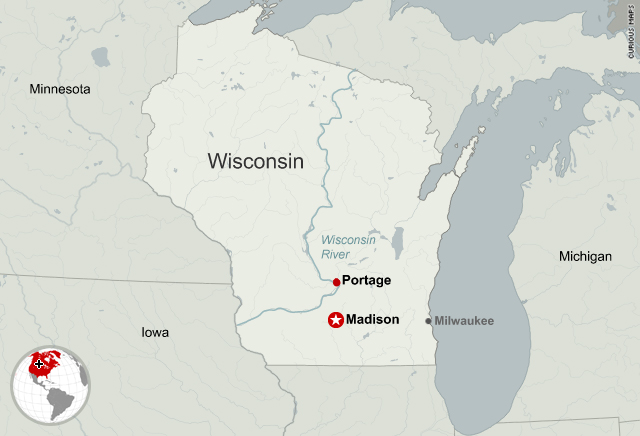Levee along Wisconsin River fails; extent of possible flooding unknown

- NEW: The Wisconsin River at Portage is expected to peak again Tuesday morning
- The levee on the Wisconsin River has now failed, according to a local emergency official
- The aging levee system is under pressure after heavy rainfall last week
- Flooding is expected to continue over the next few days
Get more coverage of floods from CNN affiliates WISC, WKOW, and WMSN in Madison, Wisconsin, and WISN in Milwaukee.
(CNN) -- As many as 100 homes could be affected by flood waters in Wisconsin due to the failure of a 120-year-old sand levee along the Wisconsin River.
The levee, near the city of Portage in Columbia County, began to give way Sunday night, according to the National Weather Service's Milwaukee/Sullivan office.
Patrick Beghin, a representative of the Columbia County Emergency Operations Center, confirmed to CNN Monday that the levee had in fact failed.
"Once the levee completely fails ... it is unknown how far south the flood waters of the Wisconsin River will travel," the Weather Service said Sunday night.
Portage Mayor Ken Jahn later told CNN that while the levee hadn't completely broken yet, it had deteriorated. Local prison inmates were being used to help with sandbagging, he said.
The levee is located on the south side of the Wisconsin River, just south of Portage. The weather agency urged residents to move to higher ground. Roadways, including parts of Interstate 39, could close.
Authorities in Portage worked to evacuate residents as the levee approached imminent failure after heavy rainfall soaked the Midwest last week.
An alert sent out by Columbia County Emergency Management (CCEM) on Sunday urged residents near Blackhawk Park to evacuate immediately ahead of the flooding, which is expected to wash out a main road leading to about 150 residences.
"Emergency vehicles including police, fire and EMS will not be able to reach residents," the statement said.
Kathy Johnson, the deputy director of the county's emergency management department, said Sunday it was unclear how many residents remained in the area.
 Map: Flooding along the Wisconsin River
Map: Flooding along the Wisconsin River
 Video: iReporter's home at edge of floodwaters
Video: iReporter's home at edge of floodwaters
 Video: Severe floods hit Midwest
Video: Severe floods hit Midwest
"Anyone in there right now won't be able to come out," she said.
A Red Cross shelter was opened at a nearby church to accommodate displaced residents.
The river at Portage is now expected to stay above flood stage -- 17 feet -- through Wednesday, Beghin said. Portage won't be considered to be out of danger until the river has dropped below flood levels, he added.
Beghin noted that the flooding situation is not as widespread as it was during a similar 1993 flood, even though the river has now crested at a higher level than it did 17 years ago.
The Wisconsin River crested around 12 a.m. Monday at 20.56 feet -- roughly 3.5 feet above flood level, according to Beghin and the National Weather Service, putting major pressure on the Caledonia-Lewiston levee system.
Forecasts suggest the river at Portage will undergo a second peak in height on Tuesday morning, adding more pressure to the compromised levee.
Officials with the Department of Natural Resources have been monitoring the failed levee for days and trying to repair problem areas. But the levee system, built in the 1890s, was constructed from locally available materials -- mostly sand -- "without any engineering design or adherence to any standards," the Natural Resources department said in a statement last week.
"This is a 120-year-old relic," Wisconsin Department of Natural Resources spokesman Greg Matthews said Sunday. "It's made of sand. ... A modern levee that our engineers would be familiar with would be constructed of steel and concrete."
The levee's failure comes after a week of rainfall that dumped as much as 11 inches of rain in parts of Wisconsin and neighboring Minnesota. Portage itself, however, did not receive any of the heavy rain.
Floodgates along the Menominee River in Niagara, Wisconsin, were opened in recent days to ease pressure on dams. Video showed a torrent of water gushing from an overflowing dam.
"I have never seen the water rage down like it is," CNN iReporter Jason Asselin said.
CNN meteorologist Jacqui Jeras said Sunday that there's no immediate end in sight to the flooding.
"Even though some of these rivers have crested ... keep in mind that they're still in flood, so this is going to be a problem for a couple of days," Jeras said. "Many of these rivers are all going to be dumping into the Mississippi River which then in turn will rise up and we'll see some flooding there, maybe in La Crosse and the Winona areas later in the week."
CNN's Don Lemon and Rob Marciano contributed to this report.
